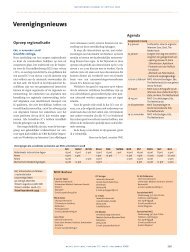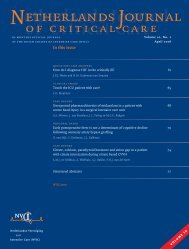Netherlands Journal
NJCC Volume 10, Oktober 2006
NJCC Volume 10, Oktober 2006
- No tags were found...
Create successful ePaper yourself
Turn your PDF publications into a flip-book with our unique Google optimized e-Paper software.
netherlands journal of critical care<br />
thrombin generated in the initiation phase activates the platelets<br />
forming a platelet plug and their surface is primed with factors Va,<br />
VIIIa and XIa.<br />
Factor IX is activated by both tissue-factors—factor VIIa complex<br />
and factor XIa, so the coagulation cascade has moved to the platelet<br />
surface where all the necessary factors are assembled ready for the<br />
propagation stage [10].<br />
Propagation<br />
Factor IXa produced in both the initiation and amplification phases,<br />
binds to the platelet surface and combines with FVIIIa to form the<br />
tenase complex (FIXa/FVIIIa/calcium). This activates FX which combines<br />
with FVa to form prothrombinase complex leading to the large<br />
scale production of thrombin. Thrombin cleaves fibrinogen to fibrin<br />
monomers, which polymerise to consolidate the initial platelet plug<br />
and form a stable clot. This thrombin generation also exerts positive<br />
feedback into the coagulation process by activating factors V, VIII, XI<br />
and Thrombin Activatable Fibrinolysis Inhibitor (TAFI).<br />
This process is localised to the site of injury by localised exposure<br />
of TF causing localised binding and activation of FVII and platelets.<br />
Factor VIIa Mechanism of Action<br />
Normal circulating levels of FVII and FVIIa are in the ratio of 100:1<br />
(10nmol/l and 0.10nmol/l respectively). Administration of rFVIIa increases<br />
the circulating concentration of activated factor 100 fold (to<br />
3-20nmol/l) [11]. Although it is widely agreed that rFVIIa acts by local<br />
activation of thrombin production there is disagreement regarding<br />
the exact mechanism by which this is achieved.<br />
There are two principal pathways – TF-dependent and TF-independent<br />
[12]. However both require the initial interaction of rFVIIa<br />
with TF, which leads to the activation of FX and thrombin formation.<br />
In the TF-dependent pathway, higher concentrations of FVIIa/TF<br />
complex go on to enhance FXa production and subsequent thrombin<br />
formation [13].<br />
In the TF-independent pathway, rFVIIa itself activates FX on the<br />
platelet surface. As platelets accumulate at the site of injury, FXa production<br />
is independent of TF [10,14]. Although this reaction is less<br />
efficient than activation by the FVIIa/TF complex, the pharmacological<br />
concentration of factor offsets this inefficiency.<br />
The continuation of both pathways requires the combination of<br />
FXa with FVa on the platelet surface to form the prothrombinase<br />
complex, which converts prothrombin to thrombin. This localised<br />
generation of large amounts of thrombin may carry the additional<br />
benefits of enhanced platelet adhesion and aggregation [15] as well<br />
as producing thinner, more tightly packed fibrin fibres and increased<br />
activation of thrombin activatable fibrinolysis inhibitor (TAFI) making<br />
the clots more resistant to fibrinolysis [16,17].<br />
It is worth noting, that since the process of haemostasis involves<br />
both coagulation and anti-fibrinolysis (as stimulated in the propagation<br />
phase described above), rFVIIa will never replace the rational<br />
use of appropriately dosed antifibrinolytic drugs. The authors believe<br />
the use of tranexamic acid should be considered in conjunction with<br />
rFVIIa administration.<br />
Laboratory Monitoring of the Effects of Factor VIIa<br />
There is no definitive laboratory test that is satisfactory for monitoring<br />
the efficacy of rFVIIa treatment. The use of Prothrombin Time (PT) is<br />
recommended but a reduction in PT does not predict clinical haemostasis.<br />
The improved clotting time reflects only the enzymatic activity<br />
of FVIIa. It is not a marker of the therapeutic efficacy of FVIIa [18].<br />
It can only be suggested that the correction of the PT to within<br />
a normal range is an indicator that the drug was administered and<br />
therefore may be beneficial [11]. The failure to reduce PT may also<br />
predict non-responders.<br />
Thromboelastography has been used to assess the effect of rFVIIa<br />
[19]. It was found that the speed of clot formation and the physical<br />
properties of the clot are improved, both of which cannot be detected<br />
by routine coagulation tests. This correlates with the mechanism of<br />
action being most probably dependant on the presence of activated<br />
platelets which are localised to the site of the injury [20]. This would<br />
also explain why there is little systemic activation of coagulation because<br />
the maximum effect of rFVIIa occurs at the site of injury. The<br />
best test of efficacy remains the observation of haemostasis.<br />
Blood Product Management.<br />
There are no universal guidelines or evidence for the efficacy of a<br />
particular regime for fresh frozen plasma (FFP), platelets, fibrinogen<br />
and cryoprecipitate replacement [21]. There is also very little information<br />
to guide the use of rFVIIa outside its licensed indications.<br />
Due to rFVIIa’s mechanism of action, severe thrombocytopaenia<br />
(







